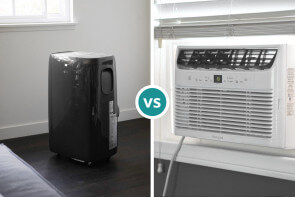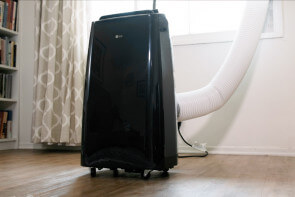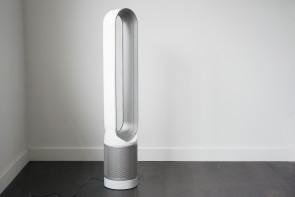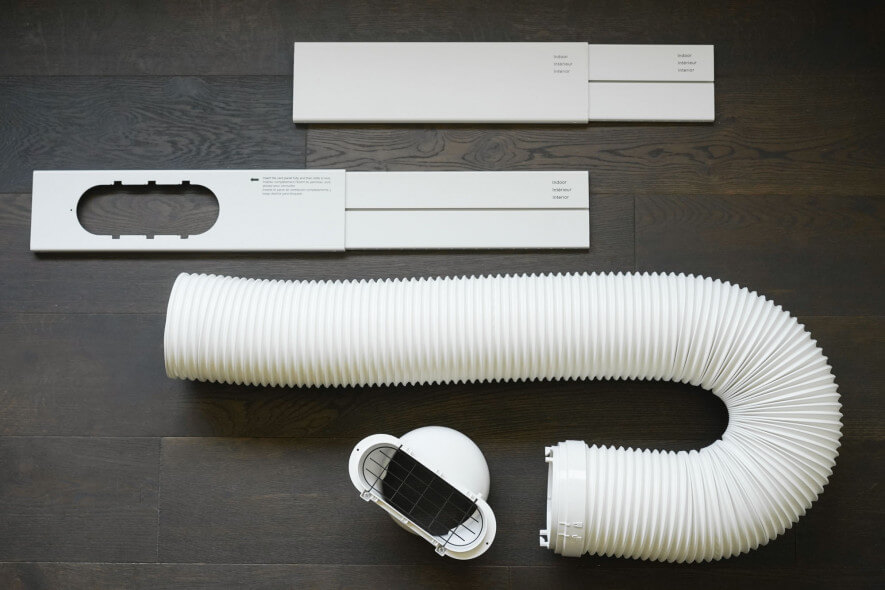
Do All Portable ACs Have To Be Vented Out A Window?
We’ve been testing the best portable air conditioners for five years, and we’ve found out all about the versatility and drawbacks of the vent hoses. These AC units are like self-contained heat pumps: They collect heat from a room and send it somewhere else through an exhaust vent. But portable ACs don’t need to vent out a window, so long as you can find another way to send the heat outside. Below we’ve outlined four other ways to vent a portable air conditioner.
General tips for venting portable air conditioners

The two most common problems with portable air conditioner vents are kinked hoses and leaking window seals.
If you find that your AC hose is getting hot, make sure you’re providing the shortest, straightest path for air to travel. See the photo above for an example of a hose with too many bends in it. Even if you have to extend the hose longer to make it straighter, bends trap more heat than length does.
You should also make sure you use the foam tape included with your air conditioner on the edges of the bracket to get a tight seal, and check around the vent for drafts. If you can’t get the window to seal completely with its own pressure on the foam, you can also add removable caulking or window sealing tape. Check out our guide to insulating windows for more ways to keep the heat from coming in.
Does it need to go outside?
A portable air conditioner uses its vent hose to remove heat, so venting it outside makes the most sense in almost every case. If the heat from the exhaust fan can come back through the intake of the air conditioner, you’re wasting money.
For most cases where you can’t vent outside, a fan will be a much more efficient way to spread heat around inside a building and keep people comfortable. See our review of the best tower fans here.
However, if you have a part of a building that gets exceptionally hot and you can’t vent directly outside, a portable air conditioner could also soak up the heat from that area and move it to a different area inside the building.
You can vent the heat through a building’s cold air return ducts directly to a central cooling system, but only so long as there’s enough capacity in that system to soak it up. Generally, if your central system can’t deal with the extra heat in a room just by redirecting the amount of air coming out of the vents, most HVAC professionals caution that you will only make the situation worse by adding a portable to the mix.
The most common reason to use a portable air conditioner without an outdoor vent is when cooling computer server racks — in this case, efficiently lowering the temperature of the room is not as important as blowing cold air directly on the hottest computer components.
Dehumidifier mode
If you need to run a portable air conditioner without any exhaust vent tube, set it to run in “dry” or “dehumidifier” mode and connect a garden hose to the top drain port so you can collect condensed water in a bucket or floor drain. In normal cooling modes, portable air conditioners evaporate the collected water and send it outside, but just circulating the humidity over and over is a waste of electricity.
Portable air conditioner venting options
Extension kits for patio doors

A patio door works just like a sliding window, but none of the portable air conditioners we’ve tested comes with enough bracket pieces to fill a 78-inch patio door opening.
You’ve got a few choices for extending the window kit that comes with your unit:
- Use cardboard, wallboard, plywood or acrylic sheets to make your own custom filler piece
- Buy a complete patio door kit like this one
- Buy additional kits to get extra extension pieces — note that for patio doors you’ll have to buy more than one extra kit to get the height you need, and they’re expensive
The DIY extension is the option that will look and work the best, if you’ve got the materials and tools to cut straight edges. You may feel that you can’t make something that looks good enough to sit in your patio door all summer, but remember that the plastic parts included in the factory kit are pretty ugly. Waterproof materials are important if you think you’ll forget to remove the bracket when it rains.
Buying more factory window kits means everything will slide together with what you have, but these kits are hard to find and expensive. Be sure you’re getting enough pieces before you sink more than $30 into extra kits.
Aftermarket patio door kits might be the best solution for some people, but finding one that’s an exact fit for the hose you’ve got might be impossible. Fortunately, sealing an air duct with tape is a simple adjustment.
Whatever you use, you can secure the bracket in the door frame with double-sided tape (or hook-and-loop tape if you’ll remove it to lock up at night) so it doesn’t fall down every time you need to open the door.
You can use a dowel, stick, or store-bought security bar to keep your patio door closed, though it’s not as secure as a locked door.
Venting through a swinging door
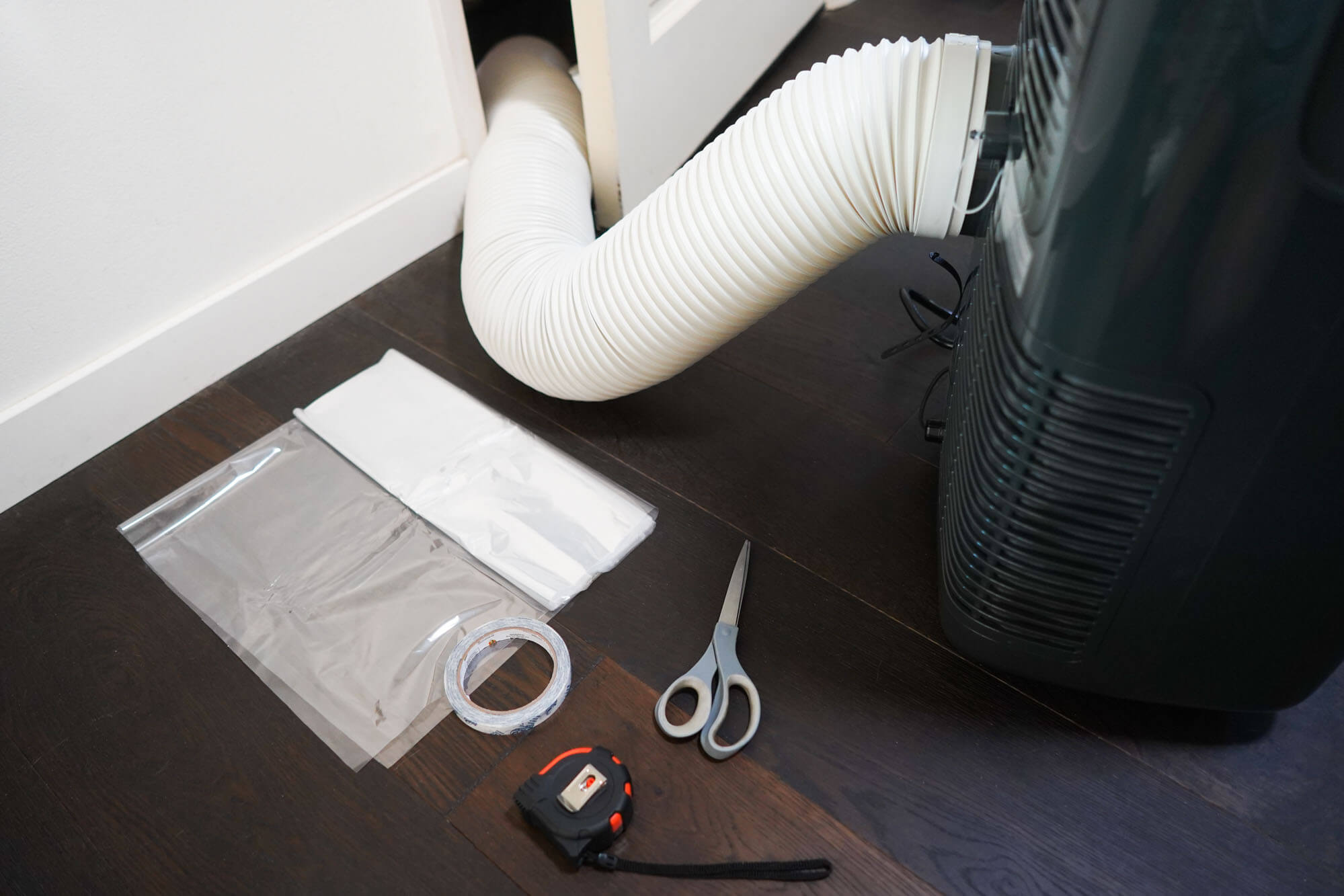
The cases where you’d benefit from venting a portable air conditioner through a door aren’t common, but there are a few.
If you have an exterior door, but no windows, sealing up the door with plastic sheets might make more sense than drilling a hole in your wall. A garage door would be a similar case, and to a certain extent a bathroom with an exhaust fan.
If you’re only running the air conditioner to deal with intense heat from something like a server rack in an interior room with no windows, venting out a door could make sense for short periods of time. Any time you’re venting into an interior space, you should monitor the temperature in the space you’re venting the heat to, making sure you don’t overheat anything.
Sealing a door isn’t difficult with plastic sheeting and tape, but there aren’t any elegant off-the-shelf solutions for making that seal easy to remove and re-use multiple times per day. If you’ve got a metal door and frame, magnets taped to the plastic sheet work fairly well.
Venting through a wall

If you’ve got the ability to install a dryer vent with a saw and drill, then you can use the same steps to vent your portable air conditioner through a wall. Just note that most portable air conditioners use 6-inch vent hoses, and dryer vent fittings are usually 4-inch.
Like with a window kit, the most important thing about this install is to provide a clear path for the air, and the seal should be tight. Luckily, running straight through the wall means you can remove most of the bend from the exhaust hose, which will help with efficiency.
If you’re setting up dedicated vents for a dual-hose air conditioner, you don’t have to get intake air from right next to your exhaust duct, or even from the same wall. Just remember that the advantage to having the second intake hose is not using up your cool room air for the heat-removing exhaust flow. If you use dryer vent parts, make sure you remove the one-way flap and use some kind of screen or mesh to prevent things from crawling in.
Venting through casement windows
If you have a swing-open or crank-open window instead of a sliding window, the kit included with a portable air conditioner won’t seal the top and bottom of that opening.
Like a swinging door, your options are either to cut plastic, wood or cardboard sheets to fill those gaps, or buy an aftermarket vinyl seal kit like this one.
The advantage to buying a kit for this purpose is that it will save you time, and they include all the hook-and-loop tape you need to make it easy to remove and re-install. The plastic bracket will hold up the weight of the dual hoses of our favorite portable air conditioner much better, though.



